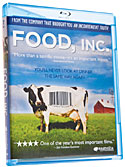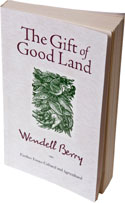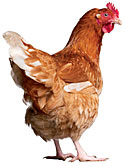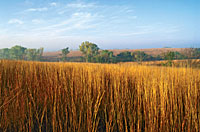sierraclub.org - sierra magazine - nov/dec 2011 - mixed media
Getting Food Right
Advice from a proud and prolific agrarian
As a multigenerational, full-time, beyond-organic farmer at odds with the global corporate food fraternity, I need a support group. What encourages and feeds my passion and my land-healing ethic? Science and emotion, empiricism and evangelism. Here are some media that have fed my soul and nourished my ministry; indeed, they've helped my earthworms dance. And they can help you live healthier. —Joel Salatin
Open UP, It's the food Police!"
 While Robert Kenner's acclaimed documentary Food, Inc. (Magnolia Home Entertainment, 2009) spells out what's wrong with mechanically based industrial food, Kristin Canty's documentary Farmageddon (2011) investigates why local food isn't more prevalent and why it is so expensive. Farmageddon examines the decline of indigenous, traditional, heritage-based food and interviews farmers who have faced down SWAT teams and the legal machinations of food police from the Food and Drug Administration, the U.S. Department of Agriculture, and state agencies. Also check out Dirt! The Movie (Docurama, 2009), which traces the development of agriculture and shows how humans are ruining the soil that sustains us.
While Robert Kenner's acclaimed documentary Food, Inc. (Magnolia Home Entertainment, 2009) spells out what's wrong with mechanically based industrial food, Kristin Canty's documentary Farmageddon (2011) investigates why local food isn't more prevalent and why it is so expensive. Farmageddon examines the decline of indigenous, traditional, heritage-based food and interviews farmers who have faced down SWAT teams and the legal machinations of food police from the Food and Drug Administration, the U.S. Department of Agriculture, and state agencies. Also check out Dirt! The Movie (Docurama, 2009), which traces the development of agriculture and shows how humans are ruining the soil that sustains us.

Fresh & Tasty App
Farm Fresh is a free app from Penn State's Cooperative Extension that gives detailed information about where to find fresh, local agricultural products, including meat and poultry, in Pennsylvania, New York, New Jersey, Maryland, and Delaware.
AGri-Manifestos
 For insight into the sustainable-agriculture movement, read Wendell Berry's The Gift Of Good Land: Further Essays Cultural And Agricultural (North Point, 1981). It's Berry's manifesto on everything that is right about environment- and community-friendly land use and everything that is wrong about mass-production agriculture. To dive into the science, check out An Agricultural Testament (Rodale, 1972) by Sir Albert Howard. First published in 1940, this text introduced the world to aerobic composting as the foundation for soil fertility.
For insight into the sustainable-agriculture movement, read Wendell Berry's The Gift Of Good Land: Further Essays Cultural And Agricultural (North Point, 1981). It's Berry's manifesto on everything that is right about environment- and community-friendly land use and everything that is wrong about mass-production agriculture. To dive into the science, check out An Agricultural Testament (Rodale, 1972) by Sir Albert Howard. First published in 1940, this text introduced the world to aerobic composting as the foundation for soil fertility.
Sally Fallon Morell started a pasture-based, localized-food revolution with Nourishing Traditions: The Cookbook That Challenges Politically Correct Nutrition and the Diet Dictocrats (New Trends, 1999), a compendium of information and recipes accentuating traditional foods prepared in ways that help ward off disease.
MEAT MAPS
 Whenever people ask, "Where can I get pasture-based meats like yours in my area?," I tell them to go to eatwild.com. Maintained by food writer extraordinaire Jo Robinson, it's the definitive clearinghouse for livestock raised the old-fashioned way—outdoors, with on-site pasture grass, instead of inside facilities. Editors recommend Eat Well Guide, where you can find local and organic farms in the United States and Canada. The American Grassfed Association has information on local grass-fed-beef producers, as well as recipes.
Whenever people ask, "Where can I get pasture-based meats like yours in my area?," I tell them to go to eatwild.com. Maintained by food writer extraordinaire Jo Robinson, it's the definitive clearinghouse for livestock raised the old-fashioned way—outdoors, with on-site pasture grass, instead of inside facilities. Editors recommend Eat Well Guide, where you can find local and organic farms in the United States and Canada. The American Grassfed Association has information on local grass-fed-beef producers, as well as recipes.
Growing Art
 Although not maintained as exhibits per se, the University Of Nebraska-Lincoln's one-acre native tall-grass prairie on the east campus and nearby 230-acre Nine-Mile Prairie are living memorials to a bygone ecosystem. Eight feet high, dense as the hair on a dog's back, and with stems more than half an inch thick, these carbon sinks hark back to the days of the buffalo. Sierra also suggests you take a look at the Fields Project, an Illinois event that marries art and agriculture in the form of field sculptures meant to be viewed from the air.
Although not maintained as exhibits per se, the University Of Nebraska-Lincoln's one-acre native tall-grass prairie on the east campus and nearby 230-acre Nine-Mile Prairie are living memorials to a bygone ecosystem. Eight feet high, dense as the hair on a dog's back, and with stems more than half an inch thick, these carbon sinks hark back to the days of the buffalo. Sierra also suggests you take a look at the Fields Project, an Illinois event that marries art and agriculture in the form of field sculptures meant to be viewed from the air.
Excerpt From Joel Salatin's Folks, This Ain't Normal: A Farmer's Advice for Happier Hens, Healthier People, and a Better World (Center Street/Hachette, 2011):
America's food companies, for all their advertising to the contrary, could not care less about health. The be all and end all is about taste manipulation, shelf life, and cheaper product. Cheaper usually means you take out the good stuff and substitute with junk. In the end, what you have is a combination that our intestinal community sees as a foreign invasion. Such a foreign language into our innards is a diabolical invasion. This is not politics; it's biological reality. Kind of a new way of looking at intestinal fortitude.
Joel Salatin is, as the New York Times calls him, the "high priest of pasture." He lives on his family-owned farm in Virginia (polyfacefarms.com).
DVD and book photos: Lori Eanes; Nine Mile Praire photo: Michael Forsberg; hen photo: iStockphoto/GlobalP